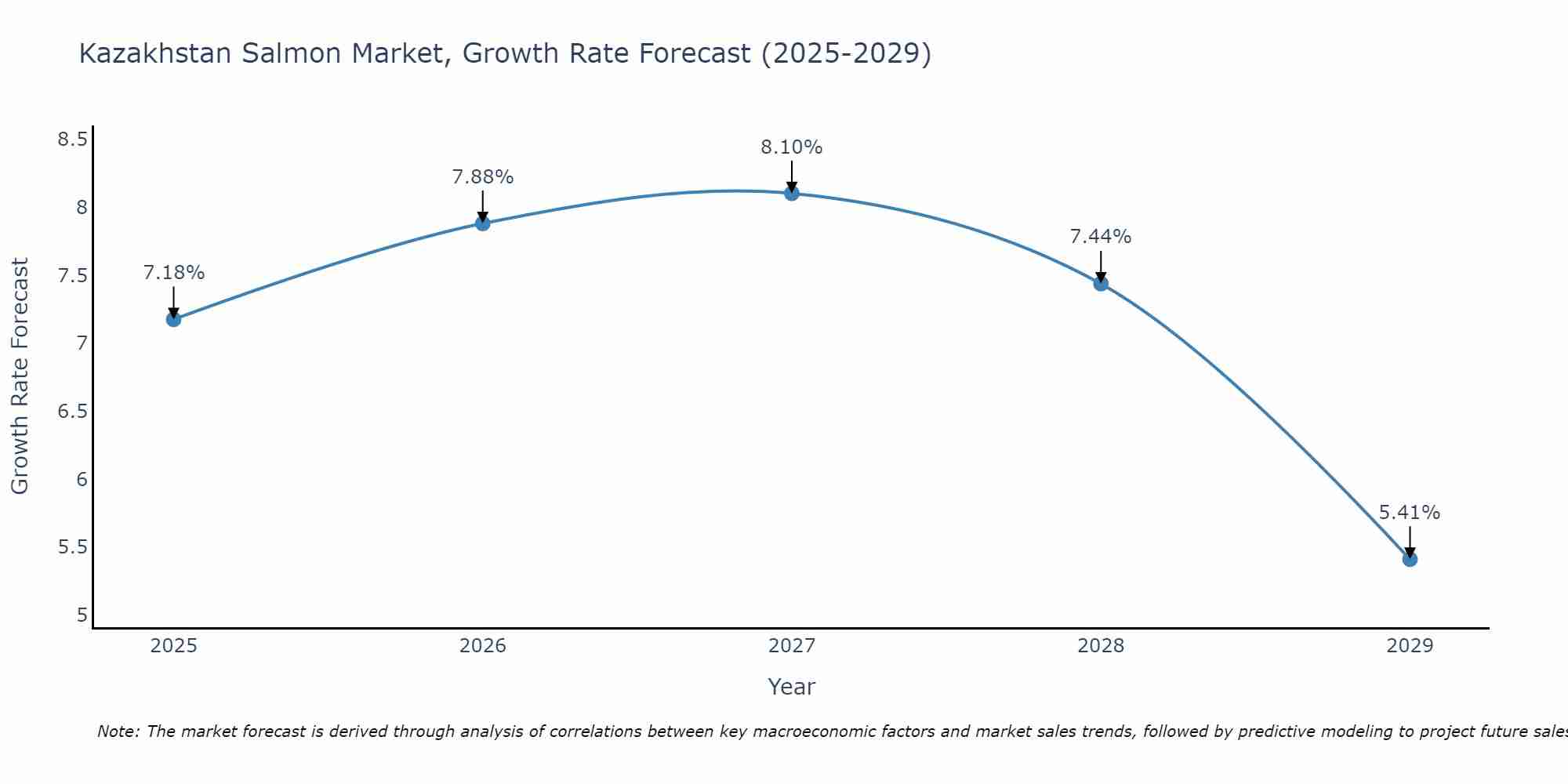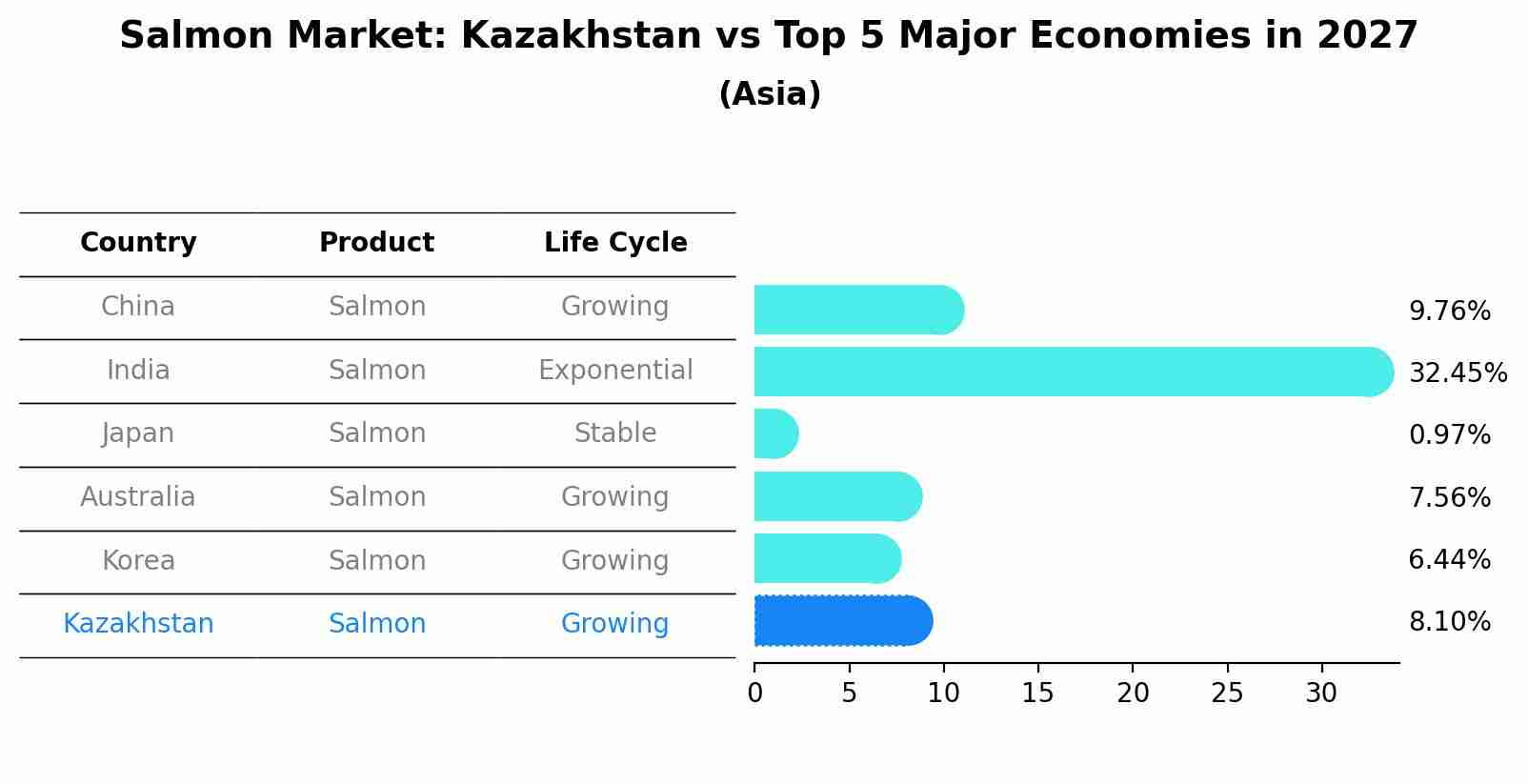Kazakhstan Salmon Market (2025-2031) Outlook | Industry, Size, Share, Analysis, Revenue, Forecast, Companies, Trends, Value & Growth
| Product Code: ETC387658 | Publication Date: Aug 2022 | Updated Date: Jul 2025 | Product Type: Market Research Report | |
| Publisher: 6Wresearch | Author: Vasudha | No. of Pages: 75 | No. of Figures: 35 | No. of Tables: 20 |
Kazakhstan Salmon Market Size Growth Rate
The Kazakhstan Salmon Market is projected to witness mixed growth rate patterns during 2025 to 2029. The growth rate begins at 7.18% in 2025, climbs to a high of 8.10% in 2027, and moderates to 5.41% by 2029.

Salmon Market: Kazakhstan vs Top 5 Major Economies in 2027 (Asia)
In the Asia region, the Salmon market in Kazakhstan is projected to expand at a growing growth rate of 8.10% by 2027. The largest economy is China, followed by India, Japan, Australia and South Korea.

Kazakhstan Salmon Market Synopsis
The Kazakhstan salmon market is experiencing steady growth due to increasing consumer awareness of the health benefits associated with salmon consumption. With a rising middle-class population and changing dietary preferences towards healthier options, the demand for salmon has been on the rise in Kazakhstan. However, the market faces challenges such as high import costs and limited domestic production capacity. Imports mainly come from countries like Norway and Russia. Retail channels, including supermarkets and hypermarkets, are the primary distribution channels for salmon in Kazakhstan. To capitalize on the growing demand, market players are focusing on product innovation, sustainability, and expanding distribution networks. Overall, the Kazakhstan salmon market presents opportunities for both domestic and international players to cater to the evolving preferences of consumers in the country.
Kazakhstan Salmon Market Trends
The Kazakhstan Salmon Market is experiencing a growing trend towards increased consumption of salmon due to its perceived health benefits and rising disposable incomes. Consumers are increasingly seeking out salmon for its high protein content, omega-3 fatty acids, and versatility in cooking. The market is also witnessing a rise in demand for premium and sustainably sourced salmon products, reflecting an increasing awareness of food quality and environmental sustainability among consumers. Additionally, the popularity of salmon as a healthy and nutritious option is driving the growth of various salmon-based dishes in restaurants and home cooking. Overall, the Kazakhstan Salmon Market is poised for continued growth as consumers prioritize health and wellness in their food choices.
Kazakhstan Salmon Market Challenges
In the Kazakhstan Salmon Market, several challenges are faced. One major challenge is the landlocked nature of Kazakhstan, which makes it difficult to access fresh salmon directly from the sea. This results in higher transportation costs and potential delays in delivering fresh salmon to consumers. Another challenge is the limited local production of salmon in Kazakhstan, leading to a heavy reliance on imported salmon from other countries. This dependence on imports makes the market vulnerable to fluctuations in international salmon prices and supply chain disruptions. Additionally, consumer awareness and preferences for salmon may vary, requiring market players to invest in educational campaigns and product differentiation strategies to attract and retain customers in the competitive market landscape.
Kazakhstan Salmon Market Investment Opportunities
The Kazakhstan Salmon Market presents promising investment opportunities due to the increasing demand for salmon products in the country. With a growing middle-class population seeking healthier food options, there is a rising interest in seafood consumption, including salmon. Investors could explore opportunities in salmon farming and processing facilities to meet the local demand and potentially tap into the export market. Moreover, partnerships with international seafood companies could provide access to advanced technology and expertise in salmon production, enhancing the quality and competitiveness of Kazakhstan`s salmon products. Strategic investments in marketing and distribution channels could further boost market penetration and profitability in this evolving market segment.
Jordan Agar Market Government Policies
Government policies related to the Kazakhstan Salmon Market focus on promoting sustainable aquaculture practices, ensuring food safety standards, and supporting the development of the domestic seafood industry. The government has implemented regulations to control the quality of salmon imports and exports, as well as to monitor the environmental impact of aquaculture activities. Additionally, there are incentives in place to encourage local production of salmon, such as subsidies for fish farms and research funding for improving breeding techniques. The government also works to facilitate market access for Kazakhstan salmon products both domestically and internationally through trade agreements and promotional campaigns. Overall, the government policies aim to enhance the competitiveness of the Kazakhstan Salmon Market while safeguarding environmental sustainability and consumer health.
Kazakhstan Salmon Market Future Outlook
The future outlook for the Kazakhstan Salmon Market appears promising due to increasing consumer demand for healthy and high-quality seafood products. As awareness about the health benefits of salmon grows among the Kazakhstani population, there is a rising trend towards incorporating salmon into their diets. Additionally, with Kazakhstan`s growing economy and increasing middle-class population, there is a greater willingness to spend on premium food products like salmon. The market is also expected to benefit from advancements in aquaculture technology and sustainable fishing practices, which will ensure a steady supply of salmon to meet the rising demand. Overall, the Kazakhstan Salmon Market is likely to experience steady growth in the coming years, presenting opportunities for both domestic producers and foreign exporters.
Key Highlights of the Report:
- Kazakhstan Salmon Market Outlook
- Market Size of Kazakhstan Salmon Market, 2024
- Forecast of Kazakhstan Salmon Market, 2031
- Historical Data and Forecast of Kazakhstan Salmon Revenues & Volume for the Period 2021 - 2031
- Kazakhstan Salmon Market Trend Evolution
- Kazakhstan Salmon Market Drivers and Challenges
- Kazakhstan Salmon Price Trends
- Kazakhstan Salmon Porter's Five Forces
- Kazakhstan Salmon Industry Life Cycle
- Historical Data and Forecast of Kazakhstan Salmon Market Revenues & Volume By Type for the Period 2021 - 2031
- Historical Data and Forecast of Kazakhstan Salmon Market Revenues & Volume By Chinook Salmon for the Period 2021 - 2031
- Historical Data and Forecast of Kazakhstan Salmon Market Revenues & Volume By Coho Salmon for the Period 2021 - 2031
- Historical Data and Forecast of Kazakhstan Salmon Market Revenues & Volume By Pink Salmon for the Period 2021 - 2031
- Historical Data and Forecast of Kazakhstan Salmon Market Revenues & Volume By Red Salmon for the Period 2021 - 2031
- Historical Data and Forecast of Kazakhstan Salmon Market Revenues & Volume By Salmo Salar for the Period 2021 - 2031
- Historical Data and Forecast of Kazakhstan Salmon Market Revenues & Volume By Silverbrite Salmon for the Period 2021 - 2031
- Historical Data and Forecast of Kazakhstan Salmon Market Revenues & Volume By End Product Type for the Period 2021 - 2031
- Historical Data and Forecast of Kazakhstan Salmon Market Revenues & Volume By Fresh for the Period 2021 - 2031
- Historical Data and Forecast of Kazakhstan Salmon Market Revenues & Volume By Frozen for the Period 2021 - 2031
- Historical Data and Forecast of Kazakhstan Salmon Market Revenues & Volume By Canned for the Period 2021 - 2031
- Historical Data and Forecast of Kazakhstan Salmon Market Revenues & Volume By Others for the Period 2021 - 2031
- Historical Data and Forecast of Kazakhstan Salmon Market Revenues & Volume By Distribution Channel for the Period 2021 - 2031
- Historical Data and Forecast of Kazakhstan Salmon Market Revenues & Volume By Retail Stores for the Period 2021 - 2031
- Historical Data and Forecast of Kazakhstan Salmon Market Revenues & Volume By Hypermarket/supermarket for the Period 2021 - 2031
- Historical Data and Forecast of Kazakhstan Salmon Market Revenues & Volume By Online Sales Channels for the Period 2021 - 2031
- Kazakhstan Salmon Import Export Trade Statistics
- Market Opportunity Assessment By Type
- Market Opportunity Assessment By End Product Type
- Market Opportunity Assessment By Distribution Channel
- Kazakhstan Salmon Top Companies Market Share
- Kazakhstan Salmon Competitive Benchmarking By Technical and Operational Parameters
- Kazakhstan Salmon Company Profiles
- Kazakhstan Salmon Key Strategic Recommendations
Frequently Asked Questions About the Market Study (FAQs):
- Single User License$ 1,995
- Department License$ 2,400
- Site License$ 3,120
- Global License$ 3,795
Search
Thought Leadership and Analyst Meet
Our Clients
Related Reports
- Canada Oil and Gas Market (2026-2032) | Share, Segmentation, Value, Industry, Trends, Forecast, Analysis, Size & Revenue, Growth, Competitive Landscape, Outlook, Companies
- Germany Breakfast Food Market (2026-2032) | Industry, Share, Growth, Size, Companies, Value, Analysis, Revenue, Trends, Forecast & Outlook
- Australia Briquette Market (2025-2031) | Growth, Size, Revenue, Forecast, Analysis, Trends, Value, Share, Industry & Companies
- Vietnam System Integrator Market (2025-2031) | Size, Companies, Analysis, Industry, Value, Forecast, Growth, Trends, Revenue & Share
- ASEAN and Thailand Brain Health Supplements Market (2025-2031) | Strategy, Consumer Insights, Analysis, Investment Trends, Opportunities, Growth, Size, Share, Industry, Revenue, Segments, Value, Segmentation, Supply, Forecast, Restraints, Outlook, Competition, Drivers, Trends, Demand, Pricing Analysis, Competitive, Strategic Insights, Companies, Challenges
- ASEAN Bearings Market (2025-2031) | Strategy, Consumer Insights, Analysis, Investment Trends, Opportunities, Growth, Size, Share, Industry, Revenue, Segments, Value, Segmentation, Supply, Forecast, Restraints, Outlook, Competition, Drivers, Trends, Demand, Pricing Analysis, Competitive, Strategic Insights, Companies, Challenges
- Europe Flooring Market (2025-2031) | Outlook, Share, Industry, Trends, Forecast, Companies, Revenue, Size, Analysis, Growth & Value
- Saudi Arabia Manlift Market (2025-2031) | Outlook, Size, Growth, Trends, Companies, Industry, Revenue, Value, Share, Forecast & Analysis
- Uganda Excavator, Crane, and Wheel Loaders Market (2025-2031) | Strategy, Consumer Insights, Analysis, Investment Trends, Opportunities, Growth, Size, Share, Industry, Revenue, Segments, Value, Segmentation, Supply, Forecast, Restraints, Outlook, Competition, Drivers, Trends, Demand, Pricing Analysis, Competitive, Strategic Insights, Companies, Challenges
- Rwanda Excavator, Crane, and Wheel Loaders Market (2025-2031) | Strategy, Consumer Insights, Analysis, Investment Trends, Opportunities, Growth, Size, Share, Industry, Revenue, Segments, Value, Segmentation, Supply, Forecast, Restraints, Outlook, Competition, Drivers, Trends, Demand, Pricing Analysis, Competitive, Strategic Insights, Companies, Challenges
Industry Events and Analyst Meet
Whitepaper
- Middle East & Africa Commercial Security Market Click here to view more.
- Middle East & Africa Fire Safety Systems & Equipment Market Click here to view more.
- GCC Drone Market Click here to view more.
- Middle East Lighting Fixture Market Click here to view more.
- GCC Physical & Perimeter Security Market Click here to view more.
6WResearch In News
- Doha a strategic location for EV manufacturing hub: IPA Qatar
- Demand for luxury TVs surging in the GCC, says Samsung
- Empowering Growth: The Thriving Journey of Bangladesh’s Cable Industry
- Demand for luxury TVs surging in the GCC, says Samsung
- Video call with a traditional healer? Once unthinkable, it’s now common in South Africa
- Intelligent Buildings To Smooth GCC’s Path To Net Zero


















